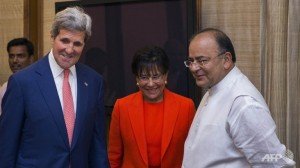Kerry India Visit – Handshakes Of Different Leaders
During his recent visit to India, US Secretary John Kerry met with a few of the leaders from the ruling party as a precursor to PM Modi’s visit to the U.S., which will be in the coming month of September. Here are a few interesting snapshots of how the leaders greeted him and offered the initial handshake.
Narendra Modi
Little needs to be said in praise of Modi’s mastery over the handshaking technique. Picture perfect! (Read Modi in Action – A Perfect Handshake)
The way Modi confidently extends his hand and maintains eye contact is an excellent example of using body language to establish rapport. Such gestures are essential for building trust and creating a positive impression, both of which are critical in shaping one’s career and achieving success in high-stakes communication.
Sushma Swaraj
The lady seems to have taken pointers from our PM and learnt all about the dominant left side of the handshake. She greets Kerry as in the picture below
The external affairs minister is quick to guide Kerry to the dias for the formal handshake pictures and does not forget to offer him the left side, much like Modi did during Sharif’s visit to India (Read Modi in Action – A Perfect Handshake) So most of the clicked pictures that you see of the duo are as below:
It is easy to see Ms. Swaraj exude amazing confidence even in this posture, where she is on the non dominant side of the handshake AND she is significantly shorter than Kerry. She does not forget the warm smile and the eye contact, but what does the trick for her is her outright extended hand. You can see how firm that handshake is, gauging by her tensed wrist muscles in the picture. The following snap shows how evidently this puts a slight discomfort on Kerry, who employs the arm on hand technique to counter Ms. Swaraj’s dominance.
Kudos to Ms. Swaraj’s confident posture, which made Kerry unconsciously defend his handshake! I hope all Indian leaders, especially females, who are generally on a back foot during this physical tie sign, learn a lesson or two from her.
Arun Jaitely
This is a picture taken before the formal handshake photo, where you can see Jaitely standing with his arms behind his back. Arms behind the back posture can be a highly confident, open posture if the palms are locked on one in the other behind the back, which is what Jaitely is doing. The next picture shows the handshake which he initially offered to Kerry.
Jaitely probably was so engrossed in the greeting that he forgot to pay attention to his hand that was not involved in the handshake – his left hand. The high confidence posture with two hands behind the back can suddenly transform into a low confidence, submissive posture if one hand is behind the back during the handshake.
Jaitely does correct his posture during the formal handshake photo shoot, but no eye contact, either with Kerry or towards the camera, again signifies lack of confidence. In moments like these, communication through gestures and postures plays a critical role in conveying one’s authority and readiness. Let’s hope Jaitely plays catch-up with his team members in terms of learning the correct handshake technique!
One might debate why it is important to put so much emphasis on an exactly correct handshake. The handshake is one of the only ways we make physical contact with the counterparty during a formal meet. Much research has gone into proving that a good handshake helps build trust. And if one can convey his confidence to the counterparty during this brief encounter, it can go a long way in helping have an upper hand in the negotiations that follow suit. Mastering this art is an essential skill for anyone aspiring for success in their career.
Written by,
Khyati Bhatt
If you want to polish your own body language you can go through our list of services and courses.

























